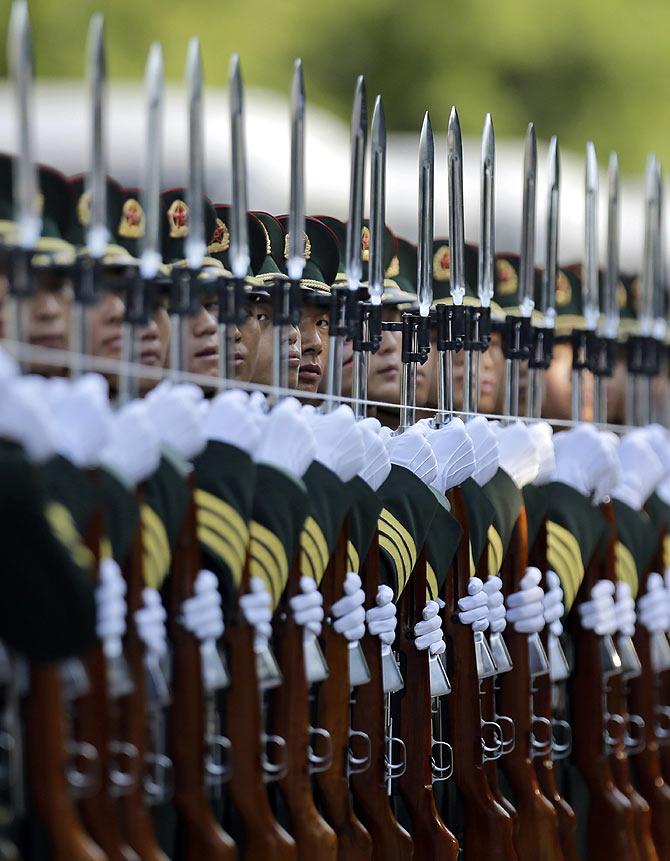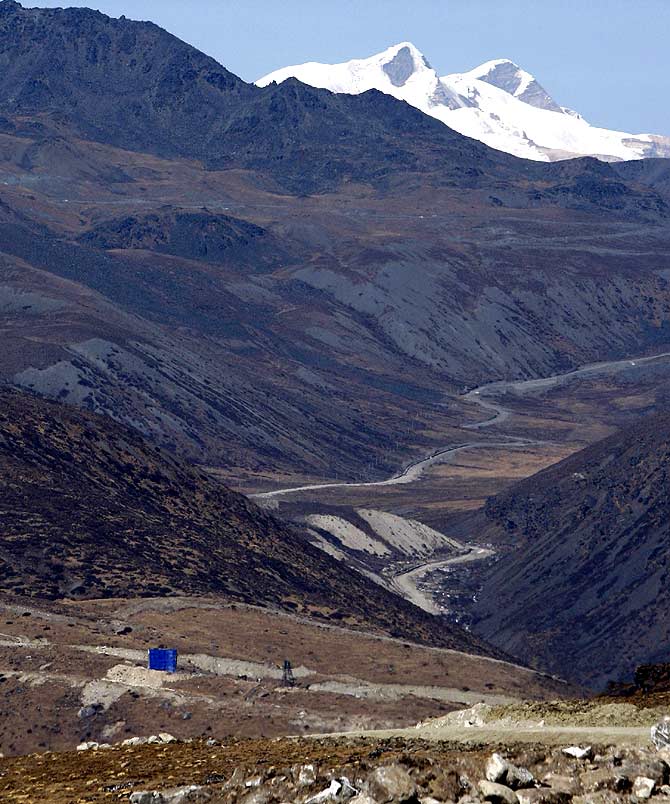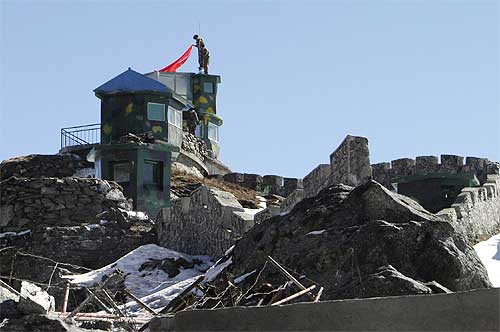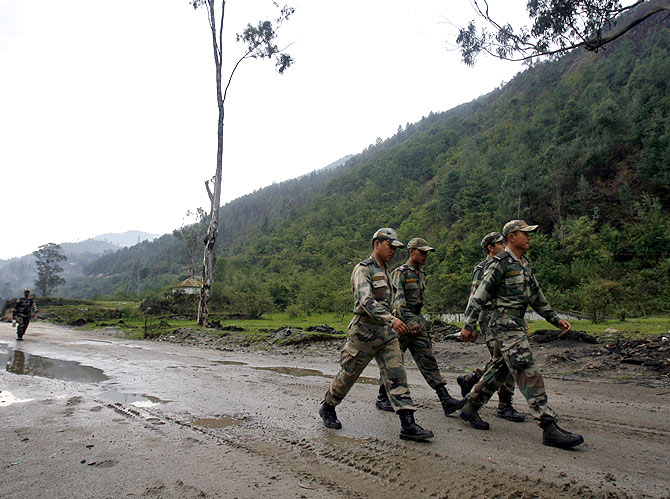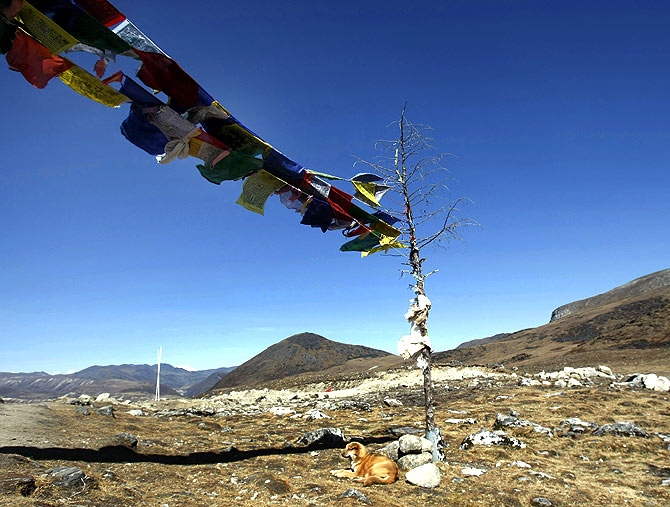 | « Back to article | Print this article |
Is there any point of the PM's China visit?
If the 1993, 1996, 2005 and 2012 border agreements have been unable to check Chinese aggressiveness, how can a fifth one succeed? asks Claude Arpi.
The Fifth India-China Strategic Dialogue was held in Delhi earlier this year. While some progress is said to have been made in narrowing the ever-growing trade (im)balance in favour of China, Beijing remained stuck on its position on the border issue as well as on a possible collaboration on the Brahmaputra and other trans-border rivers.
After the meeting, it was reported that 'both sides put their faith in the most recent bilateral mechanism, the [2012] Working Mechanism on Border.'
Well, this has not stopped the Chinese from intruding into India's territory.
Foreign Secretary Sujatha Singh and her Chinese counterpart Vice Foreign Minister Liu Zhenmin (who served many years as Director-General, Department of Treaty and Law in China's ministry of foreign affairs) wanted to finalise a fresh Border Defence Cooperation Agreement, BDCA.
At a time the Chinese regularly try to create trouble on the Line of Actual Control, can a new agreement be more efficient than the previous ones of 1993, 1996, 2005 and 2012?.
One wonders why a new BDCA?
Please click Next to read further...
The Chinese have extended their intrusions to Arunachal
For months, the media has mentioned incursions across the LAC in Ladakh, whether it is near Daulat Beg Oldi, Siri Jap, Chumar or Demchok.
Now, it appears that the Chinese have extended their intrusions to Arunachal Pradesh, particularly to the Anjaw district.
Former BJP MP Tapir Gao claimed that the People's Liberation Army, PLA, has intruded at least 30 to 40 km into Indian territory after over-running at least six of the nine Indian check-posts. Gao affirmed that the face-off continues near the McMahon Line.
Talking to The Assam Tribune, Gao asserted that the incursion started around August 12. He explained that a group of BJP workers visited the area, located near Chaglagam in Anjaw district, and confirmed the veracity of the information.
According to Gao, some 200 PLA personnel are occupying six unmanned check-posts, which serve as temporary camps for Indian forces patrolling in the area. Chaglagam is the last administrative circle located some 108 km south of the McMahon Line.
Gao explained that ever since the incursion took place, some 1,500 or 1,600 local people live in constant fear. The local administration has apparently informed Itanagar, Arunachal Pradesh, about the incident.
Please click Next to read further...
A coordinated effort to pester India
Like in Ladakh, one of the problems is that the Indian Army is not deployed in the area; only 70 to 80 Indo-Tibetan Border Police troops are left facing the Chinese PLA.
Another local source said: "There are no roads or regular supply chain from our side to the areas occupied by the Chinese, so the Indian Army has to move on foot. The situation is grim as our local people are worried that the PLA may not vacate the occupied areas. Why does the Government of India not understand the gravity of the situation?"
A source told The Indian Express that India did not want to escalate the tension and efforts were on to resolve the differences.
An important point to note is that the Chaglagam incursion by the PLA depended on the Chengdu Military Region and not the Lanzhou Military Region like the ones in Ladakh and the Central Sector (Barahoti).
It demonstrates a coordinated effort from the Central Military Commission in Beijing to pester India, which is too slowly catching up in terms of infrastructure development.
Please click Next to read further...
Lack of roads impedes Indian Army patrols
Last year, a local newspaper in Arunachal Pradesh spoke of Delhi's 'reluctance to upgrade its resources along the international border in Arunachal Pradesh.'
'One glaring example is the border demarcation along the Indo-China border near Chaglagam outpost in Anjaw district,' the newspaper noted. 'Due to lack of proper boundary demarcation, the Chinese army often intrudes through two passes of Glai Takre and Hadira Takre which are about 100 km from the last ITBP base camp situated at Chaglagam.'
At that time, Anjaw Zilla Parishad Chairperson B Tega had explained that the Chinese often intrude in the area and put up 'unknown signs and symbols on stones and trees inside Indian territory.'
After the departure of the Chinese, Tega said Indian patrols were quick to erase the Chinese military marks and signs.
The Zilla Parishad leader had then suggested: 'The Indian government needs to establish military camps at Tanya, Pompom and Laitakru areas for security and easy monitoring of border areas.'
In 2012, a Chaglagam district official had told the local press: 'Due to non availability of proper motorable road from Chaglagam to Glai Takre and Hadira Takre, the Indian patrolling team takes 4 to 5 days to reach the border; this poses a danger during emergency time.'
The official urged the government to widen the Chaglagam-Hayuliang road for transportation of military and other heavy vehicles; she stated: 'The Chinese government has connected its border area with highways. On the other hand, India is yet to make any roads leading to all border posts in Arunachal Pradesh even today.'
Please click Next to read further...
The government must tell the Indian people what is going on
These incursions are not happening only in Arunachal Pradesh. On July 25, The Hindustan Times, quoting some top government source, reported that some 21 PLA troops crossed the LAC in Barahoti area of Uttarakhand.
It appears that the Chinese soldiers moved back after straying across the LAC for more than an hour. HT said: 'This was the third straight intrusion this month apart from a face-off in Chumar on July 16-17, and another one on July 12-13 in Arunachal Pradesh.'
This particular incident in the Central Sector occurred after maps have been exchanged between India and China. It is the only sector where it has been done.
The intrusion took place just before Joint Secretary (East) Gautam Bambawalla met a Chinese delegation headed by the Director General (Boundary Affairs) to discuss steps to make the LAC peaceful.
During the two-day official-level talks held under the 2012 agreement, the Indian and Chinese sides discussed ways to maintain peace along the LAC; MEA Spokesperson Syed Akbaruddin admitted: 'The delegations reviewed recent developments in the India-China border areas.'
Tapir Gao demanded the immediate deployment of the Indian Army in the area; he also asked Defence Minister A K Antony to pay a visit in Chaglagam.
In these circumstances, is there any point for a prime minister to visit China?
If the 1993, 1996, 2005 and 2012 agreements have been unable to check Chinese aggressiveness, how can a fifth one succeed?
The Chinese reasoning is that the new agreement could bring peace on the condition that India accepts to freeze the development of the border areas.
Another sign that relations are not what they should be is that according to an official release, the two sides discussed 'enhancing understanding on the utilisation of trans-border river waters.'
Here again, the Chinese are not ready to set up a proper working mechanism to dispel Indian fears that the waters of the Brahmaputra will be diverted.
The time has come for the government to publish a White Paper and tell the Indian public what is going on. Why is a new agreement required when we already have four?
Jawaharlal Nehru used to regularly issue White Papers (15 White Papers were published between 1959 and 1965). Why does the present government not do the same? It would be wise before they lose the files!
